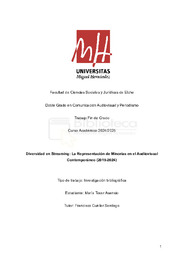Resumen :
Este Trabajo de Fin de Grado analiza la representación audiovisual de grupos
minorizados, focalizándose en la manera en la que las plataformas de streaming
influyen en la creación de historias más diversas y en la presencia de estos grupos.
El principal objetivo es explorar si existen cambios notorios entre los años 2019 y
2024 y descubrir si han derivado en representaciones más equitativas, o siguen
repitiendo estereotipos bajo nuevas estrategias comerciales.
Para ello, se ha realizado un análisis de contenido de varias producciones, unido a
un conjunto teórico: la teoría del efecto cultivador de George Gerbner, la teoría de la
espiral del silencio de Elisabeth Noelle-Neumann, la teoría de la representación de
Stuart Hall, los estudios de Laura Mulvey y Judith Butler, y la teoría de la
identificación. Las producciones elegidas pertenecen a 4 plataformas: Netflix, Prime
Video, Disney +, y Max, de las cuales se ha hecho una evaluación de sus políticas
DEI1
.
Los resultados nos muestran que, aunque hay una mayor presencia de personajes
de grupos minorizados, en varios casos supone una respuesta a una estrategia de
tokenismo, más que una verdadera inclusión. También se constata que los relatos
continúan estando influenciados por intereses comerciales, algo que impide la
renovación de los discursos hegemónicos.
En conclusión, el trabajo evidencia la evolución de la representación de minorías en
los últimos 5 años gracias al papel de las plataformas de streaming, pero con ciertas
barreras estructurales. Es esencial continuar cuestionando los patrones actuales de
inclusión para eludir la prolongación de estereotipos y llegar hasta una
representación más auténtica y más justa.
This Final Degree Project analyzes the audiovisual representation of minority
groups, focusing on the way the streaming platforms influence the creation of more
diverse stories and the presence of these groups. The main objective is to explore if
there are notable changes between 2019 and 2024, and discover if they have
resulted in more equitable representations, or continued to repeat stereotypes under
new commercial strategies.
For this purpose, a content analysis of several productions has been carried out with
a theoretical framework: Cultivation Theory (George Gerbner), Spiral of Silence
Theory (Elisabeth Noelle-Neumann), Representation Theory (Stuart Hall), Laura
Mulvey´s and Judith Butler´s studies, and Identification Theory. The selected
productions belong to 4 platforms: Netflix, Prime Video, Disney+, and Max, for which
an evaluation of the impact of their DEI policies has been made.
The results show us that although there is a better presence of characters from
minority groups, in several cases it is a response to a tokenism strategy, rather than
a true inclusion. It is also noted that the stories continue to be influenced by
commercial interests, something that blocks the renewal of hegemonic discourses.
In conclusion, this work shows the evolution of minority representation in the last 5
years, thanks to the role of streaming platforms, but with certain structural barriers. It
is essential to continue questioning current patterns of inclusion to avoid the
prolongation of stereotypes and achieve a more authentic and fairer representation.
|
 La licencia se describe como: Atribución-NonComercial-NoDerivada 4.0 Internacional.
La licencia se describe como: Atribución-NonComercial-NoDerivada 4.0 Internacional.
.png)
